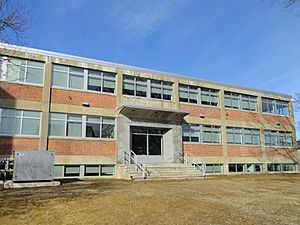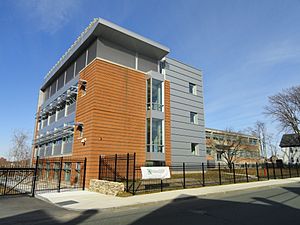Lawrence Experiment Station facts for kids
The Lawrence Experiment Station is a very important place in history. It was the world's first special station to test how to make drinking water clean and how to treat wastewater. This amazing station started in 1887 in Lawrence, Massachusetts.
Today, it is known as the Senator William X. Wall Experiment Station. A new building, about 22,000-square-foot (2,000 m2) (which is like a big gym), opened in 1954. In 1975, it was named a National Historic Civil Engineering Landmark. This means it's a really important place for engineering history! The station was renamed in 1993 after Senator William X. Wall. He worked hard to get the new building built in the 1950s.
Contents
The Station's Early Days
The Lawrence Experiment Station was created by the Massachusetts State Board of Health. This happened because scientists like William Thompson Sedgwick and Theobald Smith discovered something vital. They learned that tiny germs in water could make people very sick.
Why the Station Was Built
In 1886, the state of Massachusetts decided it needed rules for clean water. This led to the creation of the station. Hiram Francis Mills, often called the "Father of American Sanitary Engineering," was in charge. Other smart people from MIT, like William Ripley Nichols and Ellen Swallow Richards, also helped a lot.
Early Research and Discoveries
At first, the station's main job was to find good ways to clean wastewater. They did many experiments in their chemistry lab. They wanted to see how filtering water worked compared to natural cleaning. During this time, scientists also found ways to identify and count tiny living things (microorganisms) in water. These studies helped set important rules for clean water in Massachusetts and other places.
Fighting Diseases with Clean Water
Two years later, a lab for studying bacteria was added. In 1893, a serious sickness called typhoid spread along the Merrimack River. The city of Lawrence then started filtering its river water. They used special filters designed by Hiram Mills.
This made Lawrence the first city in America to filter its water to stop diseases. After they started filtering, fewer people got typhoid fever. The overall death rate in the city also went down a lot. This showed how important clean water is for everyone's health.
The Station Today
The Lawrence Experiment Station is now part of the Massachusetts Department of Environmental Protection (DEP). It is a key part of their Division of Environmental Laboratory Sciences. The station helps all DEP programs by providing scientific and lab support.
In 2011, the station got a big upgrade. A new 13,000 square foot addition was built. This new part is very modern and is LEED certified. This means it was built using environmentally friendly methods. It also holds the state's lab for workplace safety.



